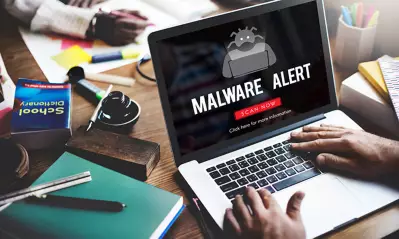Articles > Cybersecurity > How to prevent ransomware attacks
How to prevent ransomware attacks

Written by Michael Feder

Reviewed by Kathryn Uhles, MIS, MSP, Dean, College of Business and IT

Ransomware appears in 44% of all data breaches, according to a 2025 Verizon report, reflecting a notable rise from the previous year. Among other forms of malware, ransomware blocks users from accessing their files, passwords or additional personal information until they pay a ransom to regain control. Find out how this affects a device and how to prevent it.
Where do ransomware attacks come from?
While malware such as viruses, spyware and bots can injure a device’s productivity, ransomware attacks will lock users out of their system until they pay to remove the malicious program.
These attacks may come from numerous sources. Whenever a user visits a compromised webpage, opens a malicious email attachment, downloads an infected program, or communicates with another user whose device is infected with malware, ransomware can attach itself to their device.
Often, this cyberthreat can reach devices device through popular digital communication tools like email and instant messaging phishing attacks. In other cases, it can spread through insecure public internet access.
At times, ransomware can also reach a device when it visits a malicious website. Known as “drive-by downloading,” this attack occurs when an unknowingly infected website is visited. Even if that website is visited for just a few seconds, the harmful program can attach to a device and cause an infection.
How does ransomware affect devices?
Ransomware attacks don’t usually begin the moment malware is downloaded. It works first by infecting the device, then by locking, and often encrypting, user data. This usually means the device can be turned on but cannot access information stored in documents or databases.
After an attacker locks down data, users typically receive a ransom demand. This offer can be made in several ways. They might notice that a background image has changed to the ransom demand. In other cases, hackers will replace files with a copy of the ransom note.
Many types of ransomware also work to maximize damage after they infect a device. Another variant, WannaCry, also uses a device to search for other devices it can attack and encrypt.
Others include locker ransomware (simply locking users out of the device), scareware (locking users out of the device or flooding the device with pop-up alerts), and leakware/double extortion (threatening users with leaking private data to the public).
Ransomware protection
Whether it's an organization or a private device user, there are several steps to take to protect devices from malicious attackers. These same steps can also help limit damage if a device is infected.
Develop an IT recovery plan
An important first step in preventing device and network attacks is to develop an IT disaster recovery plan. This plan helps the entire organization protect against threats while identifying critical first steps in the event of an attack.
One IT disaster recovery plan can look different from another organization’s plan. It’s important to customize a plan to the size and strengths of an organization and ensure all employees are aware of the plan’s steps in the event of an infection.
The right IT disaster recovery plan helps with far more than post-attack recovery, and should also include the following elements:
- Prevention — Actions the IT team and an entire organization can take that help to deter damage and perform surveillance on all important devices.
- Mitigation — Measures that help reduce the chance of an attack ever taking place.
- Preparedness — Activities that help users remain vigilant against threats, including anticipatory response training.
- Response — Plans that outline how users respond in the event of a ransomware attack occurring, either on a single device or across an organization.
Keep systems up to date
Updating device systems is an even simpler approach to preventing ransomware attacks. Attackers often target users with outdated devices or with outdated device operating systems because their security parameters can be less protected.
After updating a device’s systems, it’s also important to update the programs used. After a sizable operating system update, for example, a device’s programs might require an update to maintain compatibility. Hackers may find vulnerabilities to target with a ransomware attack if updated devices use outdated programs.
Maintain backups
Whether information is stored on a server or in the cloud, it’s important to maintain backup files. Store backup files in a separate location, preferably on a different device, to keep them accessible if users ever need them.
During a ransomware attack, backup files can often save an organization thousands, if not millions, in lost payments. Without backup files, an organization may need to spend time and money pursuing IT strategies that help restore file access.
It's vital to frequently update backup files to ensure they reflect any changes. Many device users trust cloud computing to back up their files securely since cloud storage solutions are typically secure and can be set to automatically back up a device’s files regularly.
Increase security on devices
Device security can be improved in various ways. Many of these strategies are preventive:
- Don’t hand out personal information.
- Log out of websites after making a payment.
- Turn off both Wi-Fi and Bluetooth connectivity when not in use.
Take more proactive steps to improve a device’s security:
- Use a VPN to encrypt the connection when using a public network.
- Read reviews and verify the reputation of an application before downloading.
- Diversify passwords and change them frequently.
- Set up two-factor authentication across all devices.
- Only use trusted device charging stations.
- Disable any app or program permissions for a camera or microphone.
- Get trained on how to spot malicious links.
These and other measures can help keep information safe, particularly when using shared or public networks.
Use an intrusion detection system
An IDS typically relies on both signature-based and anomaly-based intrusion detection. Signature-based protection compares ransomware threats to trends in a network to identify possible threats before they affect device performance. Anomaly-based detection uses machine learning to classify all device activity as normal or risky, depending on how users on a network normally operate.
Consult professionals
IT professionals can help with every phase of system protection, including proactive device protection, backing up files, regularly scanning device activity and even mitigating issues after an attack.
If someone is considering joining the evolving world of cybersecurity, they’ll need to complete a few initial steps. Many employers prefer candidates with at least an undergraduate degree in technology. Students sometimes prefer online technology degrees, given the greater flexibility and the freedom to work while they learn.
Aspiring cybersecurity professionals may choose to pursue a bachelor’s degree in information technology, which can help prepare them to mitigate and prevent IT risks like ransomware attacks and other malware. This degree sharpens key skills in systems analysis, information systems, operations and cybersecurity.
Learn more about ransomware attacks, malware, and other threats in an information technology program
Whether you’re seeking to gain a understanding of cybersecurity issues like ransomware attacks, or are a working professional looking to expand your skill set, University of Phoenix (UOPX) offers online course collections, bachelor’s degrees and master’s degrees in internet technology:

ABOUT THE AUTHOR
A graduate of Johns Hopkins University and its Writing Seminars program and winner of the Stephen A. Dixon Literary Prize, Michael Feder brings an eye for detail and a passion for research to every article he writes. His academic and professional background includes experience in marketing, content development, script writing and SEO. Today, he works as a multimedia specialist at University of Phoenix where he covers a variety of topics ranging from healthcare to IT.

ABOUT THE REVIEWER
Currently Dean of the College of Business and Information Technology, Kathryn Uhles has served University of Phoenix in a variety of roles since 2006. Prior to joining University of Phoenix, Kathryn taught fifth grade to underprivileged youth in Phoenix.
This article has been vetted by University of Phoenix's editorial advisory committee.
Read more about our editorial process.
Get your free IT Program Guide
Learn how 100% of our IT degree and certificate programs align with career-relevant skills.
Get your free IT program guide. Please enter your first and last name.
Thank you
Download your pdf guide now. Or access the link in our email.


